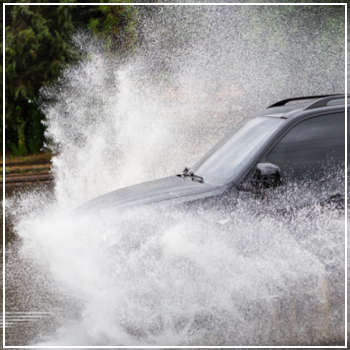Contrary to popular belief, it doesn’t take much water to cause significant problems for your car. While it typically takes a couple of feet of rushing water to sweep your vehicle away in a flood, just a few inches can wreak havoc on your engine and other internal components. Before you venture out after a major storm, keep these risks in mind. Generally speaking, avoid speeding through puddles or flooded roads whenever possible. For starters, you can’t always predict how deep the water is—what seems shallow might actually be deeper than expected. Additionally, you can’t see beneath the surface, so submerged objects like rocks or debris could puncture your tires, leaving you stranded. Beyond these visible hazards, driving through moving water that’s at least four inches deep or standing water that’s six inches deep can severely damage your car’s critical systems: Rushing through floodwaters increases the risk of hydroplaning, which compromises your control over the vehicle. Depending on the situation, this could lead to accidents involving other cars, pedestrians, or nearby structures. If your car stalls while driving through floodwaters, attempting to restart it is ill-advised. Doing so forces more water into the engine, potentially worsening the damage and increasing repair costs. Flooding poses multiple threats to your car’s engine when driving through standing water. The faster you go, the more likely you are to splash water onto your engine, especially if you exceed 25 mph. Your engine isn’t the only vulnerable part; water can infiltrate through vents, leading to transmission failures. Water can also enter the air intake, allowing it to flow into the engine’s cylinders. This creates hydrostatic lock, freezing the pistons and halting the engine, which impacts other vital components as well. Even a small amount of moisture can trigger this issue. After driving through a flood, inspect the area under the bumper. If you notice any moisture or dampness, there’s a good chance water entered the air intake and may have caused engine damage. Just because your car starts the following day doesn’t mean it’s safe to use. Hidden issues could lurk beneath the surface. Even if no visible moisture is detected, always check the oil and other fluids. A telltale sign of trouble? Finding water in the oil, differential fluid, or transmission fluid. Examine the belts and intake manifold closely. While you can perform a preliminary inspection yourself, it’s best to have a professional mechanic or technician thoroughly assess your vehicle for any signs of damage. Beyond checking the mechanical and electrical systems, the fluids will likely need flushing and replacement. Worried about flood damage to your car? Bring it to DaSilva’s Auto Body for a detailed evaluation. To schedule an appointment, contact us today. Driving through floods is never ideal, but sometimes it’s unavoidable. Whether it’s a sudden downpour or a burst water main, understanding the risks helps protect both you and your vehicle. Remember, prevention is key—avoid flooded areas whenever possible, and always consult a professional if you suspect damage. Stay safe out there! Iron Sulfide For Casting Core Wire
Pyrite as Fillers Used in Steelmaking and Core-Spun Yarn
Steel-making/casting core-clad wire (filling material)
Place of Origin: Henan Luoyang, China
Pyrite, Iron Pyrites, pyrites lump, Ferro sulphur, Pyrites powder.
Product Description:
Detailed introduction: Is used as the filling material of cored wires and resulfurization additive agent for steel-making and casting. It is used for adding sulfur element in steel smelting to improve the cutting performance, inoculation effect, graphite shape and mechanical properties of gray pig iron.
Quality:
S: 48%min, FE: 42%min, SIO2: 3.0%max, PB: 0.1%max,
ZN: 0.1%max, AS: 0.1%max, . C: 0.3%max, CU: 0.2%max,
H20: 1.0%max, SIZE: 95%min
Granularity: (0-3)mm/(3-8)mm/(3-15)mm/(15-50)mm or other particle size.
Packing: 25KG/500KG/1000KG/BAG or 1000KG/BAG or other packaging.
Note: if there are special requirements, the product can be customized according to clients` requirements.
Iron sulfide for export cored wire,High quality iron sulfide for cored wire,Customizable iron sulfide for cored wire LUANCHUAN COUNTY HENGKAI METALLURGICAL MATERIALS SALES CO.,LTD , https://www.pyritechina.com After a heavy downpour, large puddles often linger, and in severe cases, nearby rivers overflow, leaving several inches of water on the roads. It might seem harmless to drive through a few inches of standing water, but how does this really impact your vehicle?
After a heavy downpour, large puddles often linger, and in severe cases, nearby rivers overflow, leaving several inches of water on the roads. It might seem harmless to drive through a few inches of standing water, but how does this really impact your vehicle?Even Small Depths Pose Risks
Hydrostatic Lock and Engine Damage
Can My Car Be Repaired?